Archive: Have you heard?
April 27, 2009
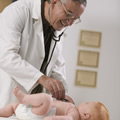
Each day, nearly 12,000 babies are born in the United States who will need to be immunized against 14 vaccine-preventable diseases before age two. Vaccine-preventable diseases are at an all-time low in the United States. But because of the success of vaccines in preventing disease in the U.S., parents are often unaware that their children are at risk for so many serious and life-threatening diseases. Celebrate National Infant Immunization Awareness week by finding out the latest recommendations from CDC. >> learn more
April 22, 2009
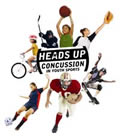
As many as 3.8 million sports- and recreation-related concussions occur in the United States each year. The potential for concussions is greatest in athletic environments where collisions are common, though the potential for a concussion can occur in any organized or unorganized sport or recreational activity. CDC developed factsheets and educational materials for coaches, parents and players. Make sure you’re staying safe on the court and in the yard. >> learn more
April 13, 2009

The Nation is growing more diverse and the related health and healthcare needs of its population are changing. The percentage of the population that is of Hispanic or Asian origin has more than double since 1980. Between 1970 and 2004, the percentage of the U.S. population that was foreign-born also more than double. CDC′s Office of Minority Health works to lessen health disparities based on race.
>> learn more
April 7, 2009
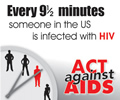
A new campaign to refocus national attention on the HIV epidemic in the United States was launched at the White House on Tuesday, April 7. Act Against AIDSis a five-year, multi-faceted communication campaign, with an initial phase to directly address complacency by reminding all Americans of the significant health threat of HIV in their own country. “9½ minutes” is the theme, and the message is simple: Right here in the United States, every 9½ minutes, someone’s brother, mother, sister, father, or neighbor is infected with HIV.
>> learn more
April 3, 2009

American travelers may not realize the flu season in Argentina and Australia and other countries south of the equator runs April through September. Influenza is the most frequently acquired vaccine-preventable disease among travelers to tropical and subtropical countries. See CDC updated recommendations for those traveling abroad.
>> learn more
April 2, 2009

According to a recent report, the rate of having a child with an autism spectrum disorder (ASD), such as autism, increases with maternal and parental age. ASDs are developmental disabilities that can cause mild to severe impairments in social interaction and communication and the presence of unusual behaviors and interests. In recognition of Autism Awareness Month, find out more about learning the signs and how you can act early to help your child reach his or her full potential.
» learn more
March 31, 2009

The transmission of onchocerciasis or river blindness has been stopped in Escuintla, Guatemala, one of the largest endemic areas in the Western Hemisphere to date to stop the transmission of the parasitic disease. The findings, published March 31st in the open-access journal PLoS Neglected Tropical Diseases, detail the lack of ocular lesions and the absence of infections in school children as well as in the black fly which spreads the disease.
» learn more
March 27, 2009

If everyone aged 50 years old or older were screened regularly, as many as 60% of deaths from colorectal cancer could be avoided. Among cancers that affect both men and women, colorectal cancer—cancer of the colon or rectum—is the second leading cause of cancer-related deaths in the United States. Colorectal cancer also is one of the most commonly diagnosed cancers in the United States. The risk of developing colorectal cancer increases with advancing age. More than 90% of cases occur in people aged 50 or older.
» learn more
March 18, 2009
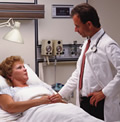
A traumatic brain injury (TBI) is caused by a blow or jolt to the head or a penetrating head injury that disrupts the normal function of the brain. Not all blows or jolts to the head result in a TBI. Of the 1.4 million who sustain a TBI each year in the United States: 50,000 die; 235,000 are hospitalized; and 1.1 million are treated and released from an emergency department.
» learn more
March 13, 2009

Kidney disease causes almost 50,000 deaths per year and is the No. 9 leading cause of death for men and women. As a disease multiplier, meaning that it can contribute to the cause of death in people with diabetes and hypertension, kidney disease is a serious public health threat.
» learn more
March 5, 2009

According to the recently released Health U.S. 2008, women live 5.2 years longer than men. Celebrate Women’s History Month finding out what women around you do to help live longer and healthier lives. Perhaps they are good at balancing calories, keeping their bones strong, or strength training.» learn more
February 25, 2009

It′s important to indulge every now and then, but knowing the basics of nutrition is essential to a healthy lifestyle. Find information on food groups, water, dietary fat, carbohydrates, protein and vitamins and minerals along with other resources outside of CDC. » learn more
February 19, 2009

The 2008 State of CDC has just been released! The summary report provides an overview of the CDC’s recent science and public health efforts as well as highlights significant accomplishments in science, partnership and emergency preparedness. The report also identifies some of the important challenges facing public health in 2009. » learn more
January 27, 2009

In 2007, only 21.4% of high school students reported eating fruits and vegetables five or more times daily (when fried potatoes and potato chips are excluded) during the past 7 days. And as research shows, prevalence of obesity among children has doubled in the last 30 years. Fruits and vegetables are part of a healthy lifestyle and you can find out how many servings you need and how they can help you manage your weight. >> learn more
January 23, 2009

An update on Hib Disease and Hib Vaccines for parents and providers is available here.
http://www.cdc.gov/vaccines/vpd-vac/hib/providers-parents.htm
January 22, 2009

As the list of recalled products associated with the Salmonella Typhimurium outbreak continues to grow, CDC encourages the public to check the FDA′s list of recalled products. For information about the outbreak and salmonella symptoms please visit CDC′s salmonella web site.
January 20, 2009

The U.S. spends more than $2 trillion on health care every year, but we are ranked 30th among the worlds healthiest nations. Find out more about what CDC is doing to make the U.S. a healthiest nation. » learn more
January 12, 2009

Cardiovascular disease caused about a death a minute among women in 2004. That translates to more deaths due to heart disease and stroke than cancer, chronic lower respiratory disease, Alzheimer′s disease, accidents and diabetes combined. CDC′s WISEWOMAN program seeks to build a world where any woman can access preventive health services and gain the wisdom to improve her health. » learn more
January 8, 2009

Salmonella, a group of bacteria that can cause diarrheal illness, are microscopic living creatures that pass from the feces of people or animals to other people. Most persons infected with Salmonella develop diarrhea, fever, and abdominal cramps 12 to 72 hours after infection. For more information on the ongoing, multistate salmonella outbreak, click here.
January 5, 2009

Neural tube defects (NTDs), major birth defects of a baby’s brain or spine such as spina bifida and anencephaly, are preventable. Affecting 3,000 pregnancies a year, NTDs can be prevented by taking B vitamin folic acid before and during pregnancy. Help CDC celebrate National Folic Acid Awareness Week » Learn more
December 29, 2008

About 75% of the alcohol consumed by adults in the U.S. is in the form of binge drinking (4 or more drinks for a woman and 5 or more drinks for a man, in one day). Make sure that you are celebrating the New Year right by being safe when it comes to consuming alcohol. »Learn more
December 22, 2008

Clean, separate, cook and chill. This four-word motto can help save your holiday meal and prevent the spread of foodborne diseases like salmonella or e. coli. Use our formatted releases or check out how you can keep the germs away. »Learn more
December 15, 2008

Before you sail off into the sunset for a holiday cruise, check out CDC’s Vessel Sanitation program, which allows you to find scores, reports and corrective actions on your favorite Cruise Line or Cruise Ship. » learn more
December 8, 2008

Every year in the United States, on average 5 to 20 percent of the population gets the flu, more than 200,000 people are hospitalized from complications and 36,000 people die from it. This week is National Influenza Vaccination Week. This year’s campaign highlights the importance of continuing flu vaccination to foster greater use of the flu vaccine through the months of November, December and beyond. » learn more
December 4, 2008

The number of people with Alzheimer’s disease doubles every 5 years beyond age 65. The disease usually begins after age 60, and risk goes up with age. About 5 percent of men and women ages 65 to 74 have Alzheimer’s disease, and nearly half of those age 85 and older may have the disease. CDC has joined the Council of State Government’s in recognizing the importance of studying the impact of cognitive impairment and Alzheimer’s disease on public health. The Council of State Government’s issued a brief that addresses the significant health, social, and economic burdens of cognitive impairment and Alzheimer′s disease. » learn more
December 1, 2008

Despite making up 12 percent of the U.S. population, blacks represented nearly half, 46 percent, of all people living with HIV in the U.S. in 2006. Unfortunately, HIV/AIDS affects about 1 million people in the U.S., and of those people, one in five do not know they are infected. CDC has developed better surveillance systems to ensure the accuracy of estimates and provide recommendations and guidelines. » learn more
November 25, 2008

A 2007 study found that if a city increased its green space by 10%, the average surface temperature could cool by up to 4 degrees. Climate change and its affects on public health are unpredictable, but CDC's expertise and programs in environmental health, infectious disease, and other fields form the foundation of public health efforts in preparedness for climate change. » learn more about what CDC is doing
November 17, 2008

A news outlet recently conducted an analysis of CDC′s Behavioral Risk Factor Surveillance System (BRFSS) 2006 data, released August 2008. The outlet ranked some cities healthiest vs. unhealthiest, but CDC does not rank cities. Click here to see the latest surveillance summary report for certain health behaviors and conditions among states and selected local areas. For general information on BRFSS click here.
November 17, 2008

Thursday is the 32nd Great American Smokeout. CDC partners with the American Cancer Society to encourage smokers, approximately 19.8% of adults and 23% of high school students, to quit.
» Learn more on how to quit smoking
November 10, 2008

Clostridium difficile, also known as C. diff or C. difficile, is a bacteria that, when found in large numbers in the intestinal tract of people taking antibiotics or other antimicrobial drugs, can cause diarrhea or life-threatening inflammations of the colon. C. difficile is responsible for tens of thousands of cases of diarrhea and at least 5,000 deaths each year, especially in healthcare settings.
» Learn more
November 6, 2008

According to a recently released report, 62% of chemical incidents reported at elementary and secondary schools resulted from human error or unintentional mistakes in the use or handling of a substance. The federal Agency for Toxic Substances and Disease Registry (ATSDR) conducts national public health surveillance of chemical incidents through its Hazardous Substances Emergency Events Surveillance (HSEES) system.
» Learn more
October 24, 2008

Trying to lose weight? According to a recently-released survey more women than men reported weight loss attempts in the preceding 12 months. Find out more statistics by age group and sex.
» Learn more
October 20, 2008

Respiratory Syncytial Virus (RSV) is a virus common in childhood and important in older adults. It′s the major respiratory virus of early infancy. RSV also can cause severe respiratory illness in people 65 and older. This virus exists worldwide, and, as with the flu, RSV infections occur seasonally. The RSV season varies, depending on where you live, but usually lasts from fall to spring.
» Learn more
October 15, 2008

Preventing Falls Among Older Adults
Unintentional falls are a threat to the lives, independence and health of older adults. And more than 90% of hip fractures among adults ages 65 and older are caused by falls. But falls are not an inevitable part of aging. Proven strategies can reduce falls and help older adults live better and longer.
» Learn more
October 15, 2008
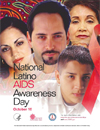
October 15 is National Latino AIDS Awareness Day
HIV remains a significant threat to the health of Latino communities in the United States. Latinos are becoming infected with HIV at a rate three times greater than whites; and while Latinos represent just 15 percent of the U.S. population, they make up 18 percent of those living with HIV/AIDS.
» Learn more
October 8, 2008

The Compendium of Strategies to Prevent Healthcare-Associated Infections in Acute Care Hospitals, a compilation of best practices to preventing and treating patients with infections, was just released along with six patient guides for the infections it covers.
» Learn more
October 2, 2008

Among adults with a disability, Black, Hispanic and Native Americans report fair or poor health at disproportionately higher rates compared with White and Asian Americans.
» Learn more
October 2, 2008

October first marks the opening of flu season and this year the Advisory Committee on Immunization Practices has added new recommendations. Make sure you know the latest changes.
» Learn more
September 26, 2008

CDC′s 19th international conference on Rabies in the Americas (RITA) will be hosted at CDC, September 28-October 3. Highlights of the conference will include an appearance by Jeanna Giese, a rabies survivor, and the signing of a North American Rabies Management plan.
» Learn more
September 25, 2008

The Advisory Committee on Immunization Practices (ACIP) recently expanded its recommendations for influenza vaccination to include all children from six months through 18 years of age.
Get the most recent CDC reports on influenza and influenza vaccination » here.
September 20, 2008

Now that kids are back hitting the books and hitting the field, it′s a good idea to make sure your child is immunized. CDC has put together a recommended regular and catch-up schedule.
» 2008 Childhood and Adolescent Immunization Calendar
September 15, 2008

Chili peppers and figs are September′s Fruit and Vegetable of the Month. Celebrate Fruit and Veggie Matter More Month with the CDC
» Learn More
September 9, 2008

More than 32,000 people kill themselves each year. Men are 4 times more likely to die from suicide, but 3 times more women attempt suicide. Get the facts and help prevent suicide during Suicide Prevention Week.
» Learn More
September 8, 2008

CDC estimates that Americans visit doctors more than 12 million times per year for skin infections typical of those caused by staph bacteria. In some areas of the country, more than half of the skin infections are MRSA. Concerned parents and health providers can help protect families with more information.
» Learn More
September 5, 2008

Preparing for hurricane season is essential for preventing disaster-related health problems. Making a plan and preparing a kit are just two ways you can get ready.
» Learn More
September 4, 2008

Now that kids are back hitting the books and hitting the field, it’s a good idea to make sure your child is immunized. CDC has put together a recommended regular and catch-up schedule.
» 2008 Childhood and Adolescent Immunization Calendar
- Historical Document: 2009, 2008
- Content source: Office of Enterprise Communication
- Notice: Links to non-governmental sites do not necessarily represent the views of the CDC.
Contact CDC:
- Centers for Disease Control and Prevention
1600 Clifton Rd
Atlanta, GA 30333 - 800-CDC-INFO
(800-232-4636)
TTY: (888) 232-6348
24 Hours/Every Day - cdcinfo@cdc.gov

